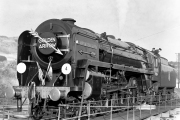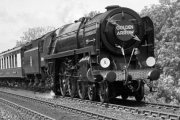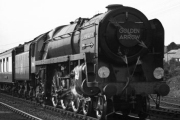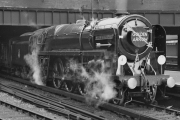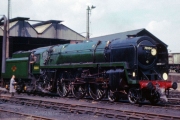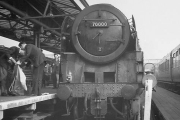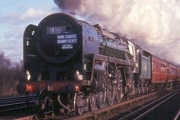Please be aware of our copyright notice. If you have a good reaon for using a photo from this site ask permission from first - it is frequently given.
BR Britannia Class 4-6-2

photograph by G. W. Morant.
|
| The Britannia Class of 7MT pacific locomotives was the first of
what was to become a successful line of Standard locomotive classes introduced
by British Railways between 1951 and 1954. The decision not to build any more
steam locomotives, despite the most recently introduced class (the Class 8P
pacific of 1954) having just one solitary example, put an end to this program
which had seen a total of twelve classes produced with an originally planned
lifespan extending into the 1990s. Designed at Derby and built at Crewe, the
Britannias hit the headlines when the first, N°70000 Britannia, was
unveiled to a generally appreciative audience. The impressive clean lines were
a further reminder that Britain was finally recovering from the dark, drab days
of the second world war, and the years of austerity that followed, and was now
firmly looking to the future. The fifth member of the class, N°70004
William Shakespeare was exhibited at the 1951 Festival of Britain on the
South Bank.
Designed by R A Riddles, the locomotives were to all intents and purposes a further development of the products of Stanier and Ivatt at the LMS, with improvements that took advantage of the lessons learned during the Locomotive Interchange Trials of 1948. One such being the adoption of the 6' 2" driving wheels that had proved so successful on the Southern's Bulleid pacifics. Twenty five were built during 1951, another thirteen in 1952, seven in 1953 and a final batch of ten during 1954. Finished in unlined black, Britannia was sent for a test run on 11th January 1951 between Crewe and Carlisle, which was completed successfully. Following this run the locomotive was painted in the new BR standard livery of lined Brunswick Green and sent to Marylebone station for her naming ceremony on 30th January 1951. The Britannias were mainly allocated to the Eastern and Western Regions of British Railways, with some going to the North Eastern and Scottish Regions, but two of the first batch, N°70004 William Shakespeare and N°70014 Iron Duke, were allocated to the Southern Region at Stewarts Lane, from where they worked the prestigious "Golden Arrow" and other boat train services, although Iron Duke is also known to have worked the "Bournemouth Belle". There is a brief clip of this loco taking the "Belle" through Basingstoke station during 1951 on the Ian Allan video/DVD "Decades of Steam, 1950s". A further loco appeared briefly on Southern metals when N°70009 Alfred the Great was allocated to Nine Elms between May and November 1951, during which time it is known to have also hauled the "Bournemouth Belle". These three locos were fitted with two middle position lamp irons welded to the brackets between the smoke box and the smoke deflectors for their sojourns on the Southern and 70004 and 70014 were also both, sometime in 1953, fitted with extended lamp irons (almost similar to the Brighton style) for the left and right buffer beam locations (the middle iron was not extended). It has been suggested this was to stop the lamps blowing out, perhaps this was something to do with the design of the Southern Railway style loco lamp. The extended irons can be clearly when comparing the disc positions in the first and second pictures above. William Shakespeare and Iron Duke were not, however, destined to be Southern engines for long as in 1958 they were transferred away to Manchester, with their places being taken by two BR Standard Class 5s, N°73041 and N°73042. No more Britannias were allocated to the Southern, although following the Crewkerne accident, which resulted in the temporary withdrawal of Merchant Navy class locomotives, a number of the Western Region's Old Oak Common allocated Britannias were drafted in to work Southern services during May 1953 in the MNs absence. These were: 70017 Arrow to Salisbury The Britannias were the first of the BR Standards, and amongst the last as N°70013 Oliver Cromwell remained in traffic to the end of BR mainline steam, not being withdrawn until September 1968. Whilst generally a successful design, the biggest complaint about them seemed to be that they could be rather "rough riders" on anything but the smoothest of roads and there were also questions about their "pulling" ability with the Western Region having to double head them on heavier trains, and a propensity for slipping when starting, cured on the Western Region by replacing the Britannias' regulators with GWR ones - but then, the GWR/BR(W) always had to be different! The class' best work was, no doubt, performed on the Dover and Norwich roads. |
|
Technical Details
|
Introduced:1 Driving Wheel: Bogie Wheel: Trailing Wheel: Length: Total Weight - Loco: - BR1 Tender: Cylinders (2): Boiler Pressure: Tractive Effort: Coal capacity: Water (BR1 tender): Power Classification:MT |
January 1951 6 ft 2 ins 3 ft 3 ft 3½ ins 69 ft 9 ins 94 tons 0 cwt 47 tons 4 cwt * 20 in x 28 in 250 lb sq in 32,150 lb 7 tons 4,250 gals 7-MT |
| As working on the Southern. Later batches had larger tenders | |||
Britannias based on the Southern |
|||
| N° | Name | Built | Transferred away |
| 70004 | William Shakespeare | 1951 | 1958 |
| 70009 | Alfred the Great | 1951 | 1951 |
| 70014 | Iron Duke | 1951 | 1958 |
read more about Standards from a Driver's viewpoint
This page was last updated 8 July 2020
